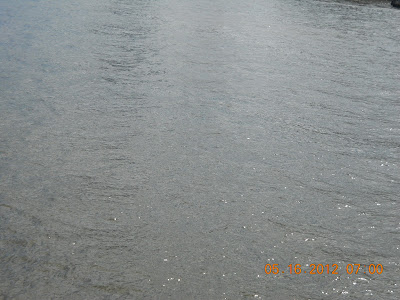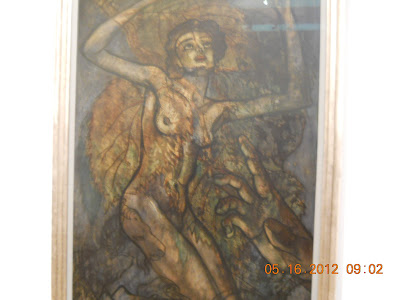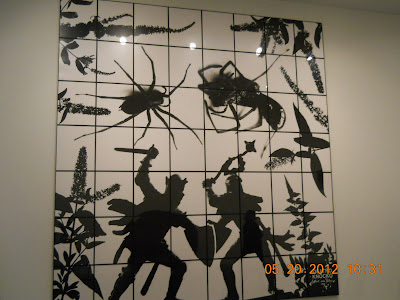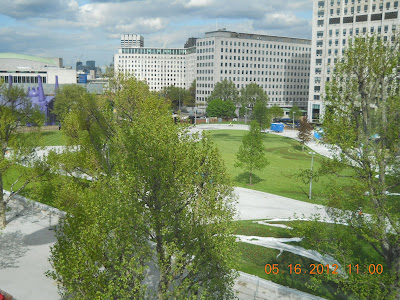Place(s) visited: Shakespeare Globe Theatre, St. Paul's Cathedral, London Eye, Millennium Bridge
Hey there! :D
There are a lot of wonderfully, fabulous places that we visited today. Every single one of them are spectacularly, beautifully architectured places to visit! Enjoy! :D
There is SO much history to be learned, that one cannot simply learn as much as one would like to learn about the history of St.Paul's Cathedral in one sitting, so to lessen the strain on the brain, I found a very helpful timeline, that will help one still learn about The History of St.Paul's Cathedral.
St.Paul's Cathedral
Timeline: 1400 Years of History










































Timeline: 1400 Years of History
From being one of the first fledgling Christian settlements to becoming an icon of the Christian faith in Britain, St Paul's has changed and grown to reflect the tastes, attitudes and people of the nation. Buildings have been constructed and have fallen, services have changed and been updated, but throughout its history St Paul's has remained a busy working church.
604
The first cathedral dedicated to St Paul's is built on the site by Mellitus, Bishop of the East Saxons.
The first cathedral dedicated to St Paul's is built on the site by Mellitus, Bishop of the East Saxons.
962
St Paul's is burnt and rebuilt in stone within the year.
St Paul's is burnt and rebuilt in stone within the year.
1087
Following a fire the church is rebuilt again by the Normans.
Following a fire the church is rebuilt again by the Normans.
1501
Katherine of Aragon marries Prince Arthur at St Paul's.
Katherine of Aragon marries Prince Arthur at St Paul's.
1526
Bishop of London preaches at Paul's Cross against Tyndale's English New Testament, which is later burnt.
Bishop of London preaches at Paul's Cross against Tyndale's English New Testament, which is later burnt.
1588
Following the defeat of the Armada, Queen Elizabeth I visits St Paul's.
Following the defeat of the Armada, Queen Elizabeth I visits St Paul's.
1606
Four gunpowder plotters are executed in St Paul's Churchyard.
Four gunpowder plotters are executed in St Paul's Churchyard.
1621
The poet, John Donne, becomes Dean of St Paul's.
The poet, John Donne, becomes Dean of St Paul's.
1633
Restoration on the Norman cathedral begins under the direction of the architect Inigo Jones.
Restoration on the Norman cathedral begins under the direction of the architect Inigo Jones.
1642-1660
The English Civil War puts a stop to work on St Paul's Cathedral.
The English Civil War puts a stop to work on St Paul's Cathedral.
1666
The Great Fire of London destroys Old St Paul's.
The Great Fire of London destroys Old St Paul's.
1668
Wren is commissioned to produce a new design for St Paul's Cathedral.
Wren is commissioned to produce a new design for St Paul's Cathedral.
1669
Wren's first design for the new cathedral is rejected.
Wren's first design for the new cathedral is rejected.
1673
Wren's second plan and Great Model are abandoned.
Wren's second plan and Great Model are abandoned.
1675
Wren's design, known as the Warrant Design, is given royal approval and the first building contracts are confirmed.
Wren's design, known as the Warrant Design, is given royal approval and the first building contracts are confirmed.
1697
The quire opens for worship while building work continues around it.
The quire opens for worship while building work continues around it.
1698
The structure reaches the height of the Whispering Gallery and work begins on the dome.
The structure reaches the height of the Whispering Gallery and work begins on the dome.
1708
'Topping out' of the Cathedral.
'Topping out' of the Cathedral.
1710
Construction on the new cathedral is completed.
Construction on the new cathedral is completed.
1711
The cathedral is declared formally complete by Parliament
The cathedral is declared formally complete by Parliament
1723
Sir Christopher Wren dies, aged 91.
Sir Christopher Wren dies, aged 91.
1790
The first memorial is erected on the cathedral floor, to John Howard, prison reformer.
The first memorial is erected on the cathedral floor, to John Howard, prison reformer.
1806
A funeral service is held for Admiral Lord Nelson after he dies at the Battle of Trafalgar.
A funeral service is held for Admiral Lord Nelson after he dies at the Battle of Trafalgar.
1852
One million people watch the Duke of Wellington's funeral procession to St Paul's.
One million people watch the Duke of Wellington's funeral procession to St Paul's.
1897
Queen Victoria's Diamond Jubilee celebrated at the cathedral.
Queen Victoria's Diamond Jubilee celebrated at the cathedral.
1913
Suffragettes plant a bomb under the Bishop's throne in the quire.
Suffragettes plant a bomb under the Bishop's throne in the quire.
1918
Crowds assemble at St Paul's on Armistice Day.
Crowds assemble at St Paul's on Armistice Day.
1940
The cathedral is the target for a bombing raid during the Blitz. During firebombing, Prime Minister Churchill declares that St Paul's must be saved.
The cathedral is the target for a bombing raid during the Blitz. During firebombing, Prime Minister Churchill declares that St Paul's must be saved.
1945
On V.E. Day, more than 30,000 flock to services at St Paul's.
On V.E. Day, more than 30,000 flock to services at St Paul's.
1958
St Paul's dedicates a chapel to commemorate American service personnel, based in Britain, who died during World War II.
St Paul's dedicates a chapel to commemorate American service personnel, based in Britain, who died during World War II.
1964
Human rights campaigner Martin Luther King preaches at St Paul's on his way to Oslo to collect the Nobel Peace Prize.
Human rights campaigner Martin Luther King preaches at St Paul's on his way to Oslo to collect the Nobel Peace Prize.
1965
Sir Winston Churchill's state funeral takes place at St Paul's.
Sir Winston Churchill's state funeral takes place at St Paul's.
1977
Queen Elizabeth II celebrates her Silver Jubilee at St Paul's.
Queen Elizabeth II celebrates her Silver Jubilee at St Paul's.
1981
HRH Prince Charles, Prince of Wales marries Lady Diana Spencer in the quire.
HRH Prince Charles, Prince of Wales marries Lady Diana Spencer in the quire.
1999
The memorial service for King Hussein of Jordan is the first Christian service in St Paul's to include a reading from the Qur'an.
The memorial service for King Hussein of Jordan is the first Christian service in St Paul's to include a reading from the Qur'an.
2001
St Paul's becomes a focus for public mourning in the UK after 9/11.
St Paul's becomes a focus for public mourning in the UK after 9/11.
2002
A national service of celebration on the Golden Jubilee of the accession of HM Queen Elizabeth II.
A national service of celebration on the Golden Jubilee of the accession of HM Queen Elizabeth II.
2003
The first female residentiary canon is installed at the cathedral.
The first female residentiary canon is installed at the cathedral.
2005
Service of Remembrance is held for the victims of the July 7th bombings on London.
Service of Remembrance is held for the victims of the July 7th bombings on London.
2006
National Service of Celebration for HM The Queen's 80th Birthday
National Service of Celebration for HM The Queen's 80th Birthday
2009
UK Prime Minister Gordon Brown and Australian Prime Minister Kevin Rudd speak at St Paul's ahead of G20 summit.
UK Prime Minister Gordon Brown and Australian Prime Minister Kevin Rudd speak at St Paul's ahead of G20 summit.
2011
The 300th anniversary restoration programme is completed.
The 300th anniversary restoration programme is completed.
This is the birthplace of all Salvation Army's! :D
Us at the Wibbly-Wobbly Bridge (Millennium Bridge)
History of Shakespeare Globe Theatre
Shakespeare Globe Theatre Today
During the first years of Elizabeth’s reign, the English playing companies used inns, inn yards, college halls and private houses for their performances. It was not until 1576 that the actor-manager James Burbage built the Theatre in Shoreditch, the first purpose-built playhouse in London. Shakespeare joined the resident troupe at the Theatre in the 1580s and the company (later known as the Chamberlain’s and then the King’s Men) flourished there for 20 years.
In 1596 a dispute arose over the renewal of the lease and negotiations were begun to acquire a disused hall in the precincts of the old Blackfriars priory to use as an indoor theatre. James Burbage died in February 1597; in April the lease expired, but the dispute continued for two years, during which time the company performed at the nearby Curtain playhouse. In Christmas 1598 the company sought a drastic solution: they leased a plot near the Rose, a rival theatre in Southwark, demolished the Theatre and carried its timbers over the river. To cover the cost of the new playhouse, James Burbage’s sons Cuthbert and Richard, offered some members of the company shares in the building. Shakespeare was one of four actors who bought a share in the Globe. By early 1599 the theatre was up and running and for 14 years it thrived, presenting many of Shakespeare’s greatest plays.
In 1613, during a performance of Henry VIII, wadding from a stage cannon ignited the thatched roof and the theatre burned to the ground ‘all in less than two hours, the people having enough to do to save themselves’. The theatre was quickly rebuilt, this time with a tiled roof. Shakespeare may have acted in the second Globe, but he probably never wrote for it. It remained the home for Shakespeare’s old company until the closure of all the theatres under England’s Puritan administration in 1642. No longer of use, it was demolished to make room for tenements in 1644.
The project to rebuild Shakespeare’s Globe was initiated by the American actor, director and producer Sam Wanamaker after his first visit to London in 1949. Twenty-one years later he founded what was to become the Shakespeare Globe Trust, dedicated to the reconstruction of the theatre and the creation of an education centre and permanent exhibition. After 23 years spent tirelessly fundraising, advancing research into the appearance of the original Globe and planning the reconstruction with the Trust’s architect Theo Crosby, Sam Wanamaker died in 1993, the site having been secured, the exhibition undercroft structurally complete and a few timber bays of the theatre in place. Three and a half years later the theatre was completed.
What did the first Globe look like? Nobody knows for sure. Printed panoramas, such as those by John Norden and Wenceslaus Hollar, give some idea of the theatre’s exterior; written accounts, usually by visitors from overseas, building contracts and one sketch (of the Swan theatre) tell us something about the interior. In addition, there are suggestive descriptions included in the plays themselves, such as the famous Chorus which begins Henry V: ‘And shall this cockpit hold the vasty fields of France / Or may we cram within this wooden ‘O’...’
Techniques used in the reconstruction of the theatre were painstakingly accurate. ‘Green’ oak was cut and fashioned according to 16th-century practice and assembled in two-dimensional bays on the Bankside site; oak laths and staves support lime plaster mixed according to a contemporary recipe and the walls are covered in a white lime wash. The roof is made of water reed thatch, based on samples found during the excavation.
The stage is the most conjectural aspect of the reconstruction. Almost nothing survives from the period to suggest the appearance of this part of the theatre. Its design was drawn from evidence provided by existing buildings of the period and practical advice offered by the actors and directors who participated in the 1995 ‘Workshop’ and 1996 ‘Prologue’ seasons.
The new Globe is also designed with the 21st century in mind. An additional exit, illuminated signage, fire retardant materials and some modern backstage machinery are all concessions to our times.
The reconstruction is as faithful to the original as modern scholarship and traditional craftsmanship can make it, but for the time being this Globe is – and is likely to remain – neither more nor less than the ‘best guess’ at Shakespeare’s theatre.
London Eye
Source 1
Source 2
London Eye Today:
Source 1
Source 2
Timeline
It’s hard to believe, but when The EDF Energy London Eye was launched as The Millennium Wheel, it was only going to be standing for a few years. But today, the London Eye has become a symbol of modern Britain; it is the UK’s number one paid-for visitor attraction and film set for TV shows and movies.
Along the way, there have been plenty of milestone moments, have a look on our timeline below.
Along the way, there have been plenty of milestone moments, have a look on our timeline below.
January 2011
The London Eye enters a new partnership with EDF Energy and becomes the EDF Energy London Eye.
November 2010
The London Eye lauches the first ever open air ice rink on the south bank, in the shadow of the London Eye.
December 2009
We continue to make history with the 36 million flights on the London Eye..
August 2009
The London Eye launches a spectacular new 4D Experience.
The London Eye goes through a re-branding.
The London Eye goes through a re-branding.
May 2009
the London Eye launches its capsule upgrade programme with removal of the first capsule
London.
London.
June 2008
We made history with the 30 million flights on the London Eye..
May 2008
The London Eye River cruise celebrated its millionth guest.
March 2007
The 25 millionth visitor was welcomed to the London Eye
March 2007
The London Eye became part of the Merlin Entertainment’s Group, the world’s number two visitor attraction operator.
February 2006
The London Eye was finally granted a 25 year lease agreement.
December 2005
The first civil partnership was performed on the London Eye. To mark the occasion, the London Eye was turned pink.
March 2005
The London Eye had its fifth birthday - 7,000 quarter bottles of Laurent-Perrier Champagne and 3,000 bottles of orange juice were given away so customers could join in the party .
February 2004
The London Eye kept turning until midnight for the first time to give lovers a romantic moment on St. Valentine’s Day.
September 2002
Our 10 millionth flight took place.
August 2002
The London Eye River Cruise was launched, quickly becoming a favourite way to see London from the River Thames.
February 2002
A new idea for Valentines Day and lovers - wedding packages allowing people to get married on the London Eye were introduced .
January 2002
The Euro was accepted at the London Eye
March 2001
The London Eye celebrated its first official birthday. During the first year alone, more than 3.5 million people came on board to fly above London.
March 2000
The London Eye officially opened to the public
October 1999
The London Eye was raised over the River Thames
Late 1998
Construction started on The London Eye, a huge international effort involving hundreds of people.
I decided to include these facts because I thought that one would be very interested in learning more about the London Eye.
Interesting things you never knew about the London Eye
A TEAM EFFORT
It took seven years and the skills of hundreds of people from five countries to make the London Eye a reality
A VIEW FIT FOR A QUEEN
You can see around 40KM (25 miles) from the top as far as Windsor Castle on a clear day
FLYING HIGH
The London Eye welcomes an average of 3.5 million customers every year. You would need 6,680 fully booked British Airways Boeing 747-400 jumbo jets to move that number of fliers!
DING! DING!
The London Eye can carry 800 passengers per revolution - equivalent to 11 London red doubled-decker buses
HEAVYWEIGHT CHAMPION
Each of the 32 capsules weighs 10 tonnes. To put that figure into perspective, it's the same weight as 1,052,631 pound coins!
SLOWLY BUT SURELY
Each rotation takes about 30 minutes, meaning a capsule travels at a stately 26cm per second, or 0.9km (0.6 miles) per hour - twice as fast as a tortoise sprinting; allowing passengers to step on and off without the wheel having to stop
THE ONLY WAY IS UP
The circumference of the wheel is 424m (1.392ft) - meaning that if it were unravelled, it would be 1.75 times longer than the UK's tallest building - One Canada Square in Canary Wharf
TONNES OF FUN
The total weight of the wheel and capsules is 2,100 tonnes - or as much as 1,272 London black cabs!
UP, UP AND AWAY
The height of the London Eye is 135m (equivalent to 64 red telephone boxes piled on top of each other) making it the fourth tallest structure in London after the BT Tower, Tower 42 and One Canada Square in Canary Wharf
BLAST OFF
The spindle holds the wheel structure and the hub rotates it around the spindle. At 23 metres tall, the spindle is around the size of a church spire and, together with the hub, weighs in at 330 tonnes: over 20 times heavier than Big Ben
London Eye Today:
Today was a FABULOUS day! :D It was long but wonderful and very fulfilling. We got a lot accomplished and we were happy. :)
Thanks for checking back! :)
Stay tuned for more updates! :D
Love,
~Lucky :) <3










































































































No comments:
Post a Comment
Thank you for your comment! I love your enthusiasm for this trip and I appreciate your understanding of the fact that if your comment does not appear immediately it is due to the fact that I have not gotten to it to approve it yet, this is for security reasons. Thanks! :)